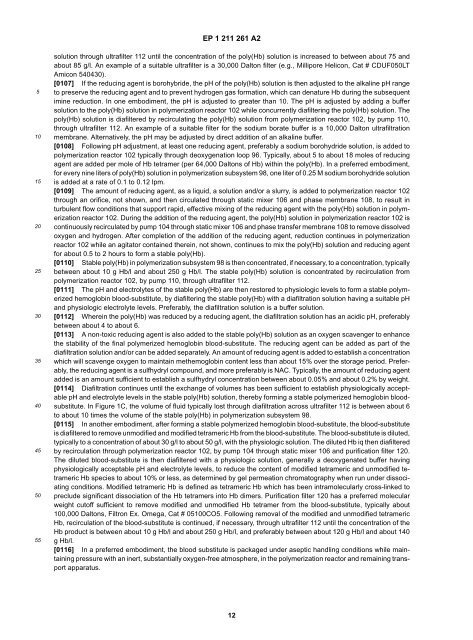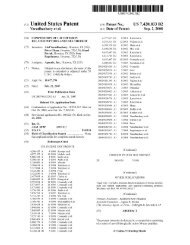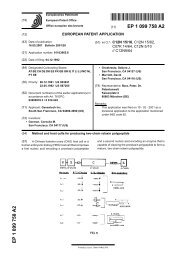EP 1 211 261 A2
EP 1 211 261 A2
EP 1 211 261 A2
You also want an ePaper? Increase the reach of your titles
YUMPU automatically turns print PDFs into web optimized ePapers that Google loves.
<strong>EP</strong> 1 <strong>211</strong> <strong>261</strong> <strong>A2</strong>510152025303540455055solution through ultrafilter 112 until the concentration of the poly(Hb) solution is increased to between about 75 andabout 85 g/l. An example of a suitable ultrafilter is a 30,000 Dalton filter (e.g., Millipore Helicon, Cat # CDUF050LTAmicon 540430).[0107] If the reducing agent is borohybride, the pH of the poly(Hb) solution is then adjusted to the alkaline pH rangeto preserve the reducing agent and to prevent hydrogen gas formation, which can denature Hb during the subsequentimine reduction. In one embodiment, the pH is adjusted to greater than 10. The pH is adjusted by adding a buffersolution to the poly(Hb) solution in polymerization reactor 102 while concurrently diafiltering the poly(Hb) solution. Thepoly(Hb) solution is diafiltered by recirculating the poly(Hb) solution from polymerization reactor 102, by pump 110,through ultrafilter 112. An example of a suitable filter for the sodium borate buffer is a 10,000 Dalton ultrafiltrationmembrane. Alternatively, the pH may be adjusted by direct addition of an alkaline buffer.[0108] Following pH adjustment, at least one reducing agent, preferably a sodium borohydride solution, is added topolymerization reactor 102 typically through deoxygenation loop 96. Typically, about 5 to about 18 moles of reducingagent are added per mole of Hb tetramer (per 64,000 Daltons of Hb) within the poly(Hb). In a preferred embodiment,for every nine liters of poly(Hb) solution in polymerization subsystem 98, one liter of 0.25 M sodium borohydride solutionis added at a rate of 0.1 to 0.12 lpm.[0109] The amount of reducing agent, as a liquid, a solution and/or a slurry, is added to polymerization reactor 102through an orifice, not shown, and then circulated through static mixer 106 and phase membrane 108, to result inturbulent flow conditions that support rapid, effective mixing of the reducing agent with the poly(Hb) solution in polymerizationreactor 102. During the addition of the reducing agent, the poly(Hb) solution in polymerization reactor 102 iscontinuously recirculated by pump 104 through static mixer 106 and phase transfer membrane 108 to remove dissolvedoxygen and hydrogen. After completion of the addition of the reducing agent, reduction continues in polymerizationreactor 102 while an agitator contained therein, not shown, continues to mix the poly(Hb) solution and reducing agentfor about 0.5 to 2 hours to form a stable poly(Hb).[0110] Stable poly(Hb) in polymerization subsystem 98 is then concentrated, if necessary, to a concentration, typicallybetween about 10 g Hb/l and about 250 g Hb/l. The stable poly(Hb) solution is concentrated by recirculation frompolymerization reactor 102, by pump 110, through ultrafilter 112.[0111] The pH and electrolytes of the stable poly(Hb) are then restored to physiologic levels to form a stable polymerizedhemoglobin blood-substitute, by diafiltering the stable poly(Hb) with a diafiltration solution having a suitable pHand physiologic electrolyte levels. Preferably, the diafiltration solution is a buffer solution.[0112] Wherein the poly(Hb) was reduced by a reducing agent, the diafiltration solution has an acidic pH, preferablybetween about 4 to about 6.[0113] A non-toxic reducing agent is also added to the stable poly(Hb) solution as an oxygen scavenger to enhancethe stability of the final polymerized hemoglobin blood-substitute. The reducing agent can be added as part of thediafiltration solution and/or can be added separately. An amount of reducing agent is added to establish a concentrationwhich will scavenge oxygen to maintain methemoglobin content less than about 15% over the storage period. Preferably,the reducing agent is a sulfhydryl compound, and more preferably is NAC. Typically, the amount of reducing agentadded is an amount sufficient to establish a sulfhydryl concentration between about 0.05% and about 0.2% by weight.[0114] Diafiltration continues until the exchange of volumes has been sufficient to establish physiologically acceptablepH and electrolyte levels in the stable poly(Hb) solution, thereby forming a stable polymerized hemoglobin bloodsubstitute.In Figure 1C, the volume of fluid typically lost through diafiltration across ultrafilter 112 is between about 6to about 10 times the volume of the stable poly(Hb) in polymerization subsystem 98.[0115] In another embodiment, after forming a stable polymerized hemoglobin blood-substitute, the blood-substituteis diafiltered to remove unmodified and modified tetrameric Hb from the blood-substitute. The blood-substitute is diluted,typically to a concentration of about 30 g/l to about 50 g/l, with the physiologic solution. The diluted Hb iq then diafilteredby recirculation through polymerization reactor 102, by pump 104 through static mixer 106 and purification filter 120.The diluted blood-substitute is then diafiltered with a physiologic solution, generally a deoxygenated buffer havingphysiologically acceptable pH and electrolyte levels, to reduce the content of modified tetrameric and unmodified tetramericHb species to about 10% or less, as determined by gel permeation chromatography when run under dissociatingconditions. Modified tetrameric Hb is defined as tetrameric Hb which has been intramolecularly cross-linked topreclude significant dissociation of the Hb tetramers into Hb dimers. Purification filter 120 has a preferred molecularweight cutoff sufficient to remove modified and unmodified Hb tetramer from the blood-substitute, typically about100,000 Daltons, Filtron Ex. Omega, Cat # 05100CO5. Following removal of the modified and unmodified tetramericHb, recirculation of the blood-substitute is continued, if necessary, through ultrafilter 112 until the concentration of theHb product is between about 10 g Hb/l and about 250 g Hb/l, and preferably between about 120 g Hb/l and about 140g Hb/l.[0116] In a preferred embodiment, the blood substitute is packaged under aseptic handling conditions while maintainingpressure with an inert, substantially oxygen-free atmosphere, in the polymerization reactor and remaining transportapparatus.12




